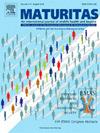绝经期和动脉僵硬指数:来自英国女性生物库队列的见解
IF 3.6
2区 医学
Q2 GERIATRICS & GERONTOLOGY
引用次数: 0
摘要
绝经是一个以激素变化为特征的重要生理转变,可影响心血管健康。一个关键问题是动脉僵硬度增加,这是心血管疾病和不良心血管事件的预测因子。然而,除了传统的心血管危险因素外,更年期和动脉硬化之间的独立联系仍不清楚。本研究调查了英国生物银行队列中绝经期和动脉僵硬指数之间的关系。方法本横断面研究包括52,891名来自英国生物银行的女性,并测量了动脉僵硬指数。采用无创光容积描记法评估动脉僵硬指数。采用多元线性和logistic回归模型检验绝经状态与动脉僵硬指数(连续和切断10 m/s)之间的关系,调整年龄、体重指数、降压药使用、收入、教育程度、血脂异常、饮酒、慢性肾病、吸烟、糖尿病、心率、平均血压、激素治疗和既往心血管疾病。结果绝经后妇女动脉僵硬指数(9.10±4.61 m/s)明显高于绝经前妇女(7.76±2.72 m/s), p <;0.001)。绝经与动脉僵硬指数升高独立相关(B = 0.22, 95% CI [0.16-0.28], p <;0.001),动脉僵硬指数10 m/s的比值比更高(OR = 1.41, 95% CI [1.31-1.51], p <;0.001),校正混杂因素后。结论绝经与动脉僵硬度升高有显著相关性,与传统心血管危险因素无关。这些发现强调更年期是心血管健康评估和预防策略的关键时期。本文章由计算机程序翻译,如有差异,请以英文原文为准。
Menopause and arterial stiffness index: insights from the women's UK Biobank cohort
Background
Menopause is a significant physiological transition characterized by hormonal changes that can influence cardiovascular health. One key concern is increased arterial stiffness, a predictor of cardiovascular disease and adverse cardiovascular events. However, the independent association between menopause and arterial stiffness, beyond traditional cardiovascular risk factors, remains unclear. This study investigates the relationship between menopause and arterial stiffness index in the women's UK Biobank cohort.
Methods
This cross-sectional study included 52,891 women from the UK Biobank with measurements of arterial stiffness index. Arterial stiffness index was assessed using a non-invasive photoplethysmographic method. Multiple linear and logistic regression models were used to examine the association between menopause status and arterial stiffness index (continuous and cutoff>10 m/s), adjusting for age, body mass index, antihypertensive medication use, income, education, dyslipidemia, alcohol consumption, chronic kidney disease, smoking, diabetes, heart rate, mean blood pressure, hormone therapy, and previous cardiovascular disease.
Results
Postmenopausal women had significantly higher values of arterial stiffness index (9.10 ± 4.61 m/s) than premenopausal women (7.76 ± 2.72 m/s, p < 0.001). Menopause was independently associated with increased arterial stiffness index (B = 0.22, 95 % CI [0.16–0.28], p < 0.001) and a higher odds ratio for arterial stiffness index >10 m/s (OR = 1.41, 95 % CI [1.31–1.51], p < 0.001), after adjusting for confounders.
Conclusion
Menopause is significantly associated with increased arterial stiffness, independent of traditional cardiovascular risk factors. These findings highlight menopause as a critical period for cardiovascular health assessment and prevention strategies.
求助全文
通过发布文献求助,成功后即可免费获取论文全文。
去求助
来源期刊

Maturitas
医学-妇产科学
CiteScore
9.10
自引率
2.00%
发文量
142
审稿时长
40 days
期刊介绍:
Maturitas is an international multidisciplinary peer reviewed scientific journal of midlife health and beyond publishing original research, reviews, consensus statements and guidelines, and mini-reviews. The journal provides a forum for all aspects of postreproductive health in both genders ranging from basic science to health and social care.
Topic areas include:• Aging• Alternative and Complementary medicines• Arthritis and Bone Health• Cancer• Cardiovascular Health• Cognitive and Physical Functioning• Epidemiology, health and social care• Gynecology/ Reproductive Endocrinology• Nutrition/ Obesity Diabetes/ Metabolic Syndrome• Menopause, Ovarian Aging• Mental Health• Pharmacology• Sexuality• Quality of Life
 求助内容:
求助内容: 应助结果提醒方式:
应助结果提醒方式:


